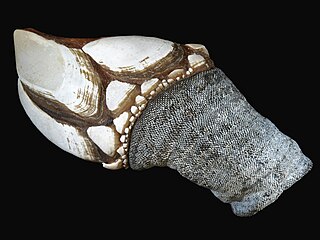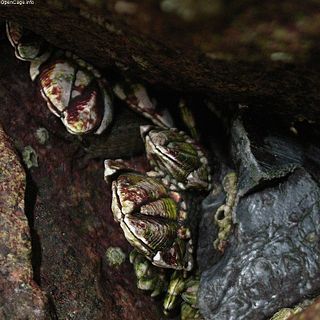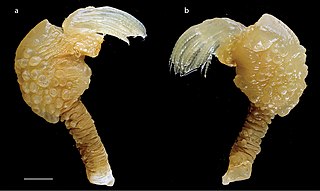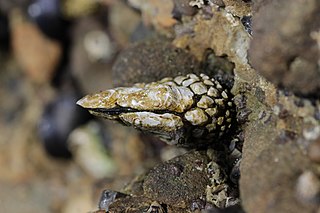
Barnacles are a type of arthropod constituting the subclass Cirripedia in the subphylum Crustacea, and are hence related to crabs and lobsters. Barnacles are exclusively marine, and tend to live in shallow and tidal waters, typically in erosive settings. Around 1,000 barnacle species are currently known.

Goose barnacles, also called stalked barnacles or gooseneck barnacles, are filter-feeding crustaceans that live attached to hard surfaces of rocks and flotsam in the ocean intertidal zone. Goose barnacles formerly made up the taxonomic order Pedunculata, but research has resulted in the classification of stalked barnacles within multiple orders of the infraclass Thoracica.

Anelasma is a monotypic genus of goose barnacles that live as parasites on various shark hosts.

Sessilia is an unranked clade of barnacles, comprising the barnacles without stalks, or acorn barnacles. They form a monophyletic group and are probably derived from stalked or goose barnacles. Sessilia is divided into two orders. The Verrucomorpha contain two families, Verrucidae and Neoverrucidae, and the remaining 14 families are in the order Balanomorpha.

Whale barnacles are species of acorn barnacle that belong to the family Coronulidae. They typically attach to baleen whales, and sometimes settle on toothed whales. The whale barnacles diverged from the turtle barnacles about three million years ago.

Megabalanus is a genus of barnacles in the family Balanidae. Members of the genus grow to 7 cm (2.8 in) in length and inhabit the lower intertidal zone.

Pollicipes pollicipes, known as the goose neck barnacle, goose barnacle or leaf barnacle is a species of goose barnacle, also well known under the taxonomic synonym Pollicipes cornucopia. It is closely related to Pollicipes polymerus, a species with the same common names, but found on the Pacific coast of North America, and to Pollicipes elegans a species from the coast of Chile. It is found on rocky shores in the north-east Atlantic Ocean and is prized as a delicacy, especially in the Iberian Peninsula.

Pollicipedidae is a family of goose barnacles.

Lepadidae is a family of goose barnacles, erected by Charles Darwin in 1852. There are about five genera and more than 20 described species in Lepadidae.

Pollicipes polymerus, commonly known as the gooseneck barnacle or leaf barnacle, is a species of stalked barnacle. It is found, often in great numbers, on rocky shores on the Pacific coasts of North America.

Capitulum is a monotypic genus of sessile marine stalked barnacles. Capitulum mitella is the only species in the genus. It is commonly known as the Japanese goose barnacle or kamenote and is found on rocky shores in the Indo-Pacific region.

Catomerus is a monotypic genus of intertidal/shallow water acorn barnacle that is found in warm temperate waters of Australia. The genus and species is very easily identified by whorls of small plates surrounding the base of the primary shell wall; no other shoreline barnacle species in the Southern Hemisphere has that feature. This species is considered to be a relic, as these plates are found only in primitive living lineages of acorn barnacles or in older fossil species. The fact that this is an intertidal species is unusual, because living primitive relic species are often found in more isolated habitats such as deep ocean basins and abyssal hydrothermal vents.

Paralepas is a genus of goose barnacles in the family Heteralepadidae.

Baía de Tarrafal or Tarrafal Bay is a bay of the Atlantic Ocean on the northwest coast of the island of Santiago in Cape Verde. The town of Tarrafal lies at its southeastern shore, and 643 m high Monte Graciosa rises from its northern shore. Most of its coast is rocky, but there is a stretch of beach near the city. The headland Ponta Preta marks the northwestern limit of the bay; there is a lighthouse on it.
Oxynaspis is a genus of goose barnacles in the order Lepadiformes.

Pollicipes caboverdensis is a species of goose barnacle in the family Pollicipedidae. It is found in rocky intertidal zones on the coasts of the islands Santiago, Sal and São Vicente, Cape Verde. The species was first described by Joana N. Fernandes, Teresa Cruz and Robert Van Syoc in 2010 after a 24.5 mm specimen collected from Ponta Preta, northwestern Santiago.
Caboverdensis and caboverdense are Latin adjectives meaning "pertaining to, or originating in Cape Verde". It may refer to any of the following species:

Dosima is a genus of goose barnacles in the family Lepadidae. There are at least two described species in Dosima.

Pollicipedomorpha is an order of pedunculated barnacles in the class Thecostraca. There are 3 families and more than 30 described species in Pollicipedomorpha.

Pollicipes elegans, the Pacific goose barnacle, is a species of gooseneck barnacle inhabiting the tropical coastline of the eastern Pacific Ocean. Its habitat borders a close relative, Pollicipes polymerus, a gooseneck barnacle covering the coastline of the Pacific Northwest. Other species belonging to the genus Pollicipes are found along the eastern coastlines of the Atlantic Ocean.
















